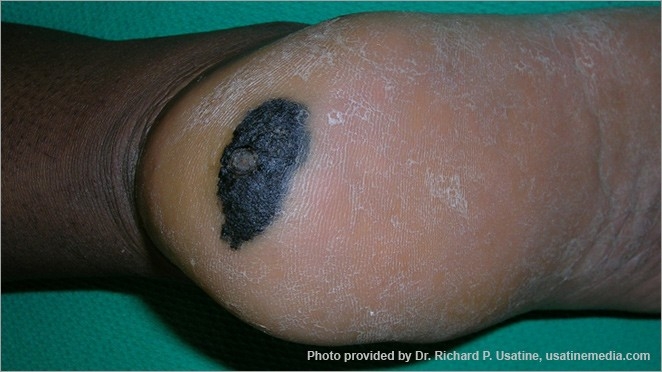Anyone Can Get Skin Cancer
While Caucasians are generally the most at risk, people of all races get skin cancer. Unfortunately, many people are under the impression that those with darker skin are not at risk for skin cancer. This is at least one reason people with darker natural skin color are diagnosed in the later stages, when the disease may be more advanced. Delayed discovery and diagnosis of skin cancer can lead to more difficult treatment, involving possible disfigurement and even death. Most skin cancers are curable if caught and treated early.

Our Skin
Human skin is comprised of three layers: the epidermis, dermis, and the subcutis. Cells in the epidermis (the outermost layer of skin) called melanocytes produce melanin, the pigment that gives skin and eyes their color. While we all have around the same amount of melanocytes, the amount and type of melanin produced by those cells varies from race to race. The darker melanin the melanocytes produce, the darker the natural skin color. Melanin helps protect the skin against damaging effects of the sun, but it does not shield the skin completely.
Natural Skin Color Vs. Tanned Skin
Ultraviolet radiation (UVR) from the sun and tanning beds stimulates melanocytes to make more melanin in an effort to block UVR from getting deeper into the skin where it can cause permanent damage and even cell mutations. This darkening of the skin, known as tanning, is different from natural skin color…it’s a sign that you’re doing damage to the skin. No matter your natural skin color, tanning is a sign that you’re doing immediate damage to both the outer layers and permanent damage to the deeper layers of your skin.

No Matter the Color…Protect Your Skin!
Most skin cancer is caused by too much UVR from the sun and tanning beds. The UVR enters the skin and causes mutations to the cells below the surface. These mutations can eventually lead to skin cancer. The darker your natural skin color, the less UVR can enter the deeper layers of skin. However, dark skin does not make you immune to UVR damage. Everyone needs to practice sun safety and check their skin for suspicious spots. Skin cancer detection is the key to finding possible skin cancers early, before they become disfiguring and even deadly! The most common forms of skin cancer are basal cell carcinoma (BCC), squamous cell carcinoma (SCC), and melanoma. Each of these has been linked to sun exposure. Tanning and sunburns can increase your risk of skin cancer, regardless of skin color. As you can see in the table below, even ethnic groups with darker natural skin tone get sunburns, which is all it takes to develop skin cancer!
Skin of Color and Melanoma
While UV exposure plays a huge role in melanoma in Caucasians, the primary reason for melanoma in people of color is often unclear. Among those of African descent, Asians, Hawaiians, and Native Americans, melanomas are most likely to appear in the mouth, or on the palms of the hands, soles of the feet and under the nails. Evidence suggests the trunk and legs are the most likely areas affected among fair-skinned Hispanics and the feet are the most common location in dark-skinned Hispanics. These melanomas may not be linked to UV exposure, so it is very important to do a skin self-examination regularly to check for new or changing spots on your skin, and see your healthcare provider immediately if you see anything unusual.
Acral Lentiginious Melanoma (ALM):
- Most common type of melanoma in people with darker skin and those of Asian descent.
- Appears on the palms of hands, soles of feet, or under the nails.
- Does not seem to be related to sun exposure. In some people, it may be due to a genetic risk factor.
- Death rates from ALM are higher than those of other forms of melanoma.
 ALM on heel
ALM on heel
 ALM growing under toenail coutesy of AIM at Melanoma Foundation
ALM growing under toenail coutesy of AIM at Melanoma Foundation
Helpful Hints For People of All Skin Colors
- Seek shade, especially between 10 A.M. and 4 P.M.
- Do not burn
- Avoid tanning and indoor tanning beds
- Use sunscreen
- Cover up with clothing, including a broad-brimmed hat and UV-blocking sunglasses
- Keep newborns out of the sun
- Examine your skin regularly
- See your physician if you find something suspicious


